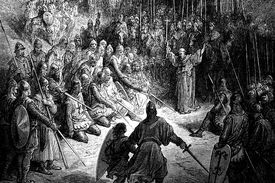Peter the Hermit: The Unlikely Leader of the People’s Crusade
Meta Description: Explore the life of Peter the Hermit, a pivotal figure in the First Crusade, who led thousands of peasants on a perilous journey to reclaim Jerusalem.
Who Was Peter the Hermit?
| Name | Peter the Hermit |
|---|---|
| Born | Around 1050, France |
| Notable Role | Leader of the People’s Crusade |
| Key Event | First Crusade (1096) |
| Death | Circa 1115 |
Peter the Hermit was an ascetic priest who played a crucial role in sparking the First Crusade. Despite his lack of military background or noble status, Peter inspired tens of thousands of ordinary people to march towards Jerusalem. His name has become synonymous with the People’s Crusade, a remarkable, if ultimately disastrous, episode in history.
Peter the Hermit and the People’s Crusade

Peter the Hermit is best known for his leadership of the People’s Crusade in 1096, which preceded the main military expedition known as the First Crusade. Heeding the call of Pope Urban II to reclaim Jerusalem from Muslim control, Peter galvanized the peasantry. His reputation as a preacher who claimed divine visions fueled a mass movement.
While the official First Crusade was made up of knights and nobles, Peter’s followers were predominantly peasants. Without the resources or military expertise of their noble counterparts, they embarked on a perilous and ultimately doomed journey. The People’s Crusade was marked by hunger, infighting, and frequent clashes with locals in Eastern Europe and Asia Minor.
Despite his zeal, Peter’s leadership was questioned as the crusaders faced overwhelming challenges. The Seljuk Turks decimated the untrained force, bringing the People’s Crusade to a tragic end.
Quote from Peter’s Biography: “The People’s Crusade was a deeply religious movement, driven more by faith than practical strategy.”
The Visionary Leader: Was Peter Divinely Inspired?
Many sources suggest that Peter the Hermit had a vision of Christ, urging him to initiate the crusade. Whether this vision was genuine or exaggerated remains debated by historians. Nevertheless, it was a key factor in rallying common people to take up arms. Peter’s message resonated particularly with the poor and disenfranchised, many of whom saw the crusade as not only a spiritual mission but also a chance for social elevation.
Peter the Hermit’s preaching emphasized themes of religious purification and divine reward, which held immense appeal to those enduring hardship in feudal Europe.
Peter’s Influence on the First Crusade
Although the People’s Crusade ended in failure, Peter survived and later joined the main army of knights and nobles during the official First Crusade. However, his role was greatly diminished. Despite his diminished role, Peter’s early efforts contributed to the momentum behind the larger Crusade, which ultimately led to the capture of Jerusalem in 1099.
It’s essential to note that Peter’s Hermit Crusade can be seen as a precursor to the main Crusade, stirring mass enthusiasm for the cause. His leadership, though flawed, represented the intense religious fervor of the time.
Life After the People’s Crusade
After the First Crusade, Peter faded into obscurity. Historical records are sparse concerning his later life. Some accounts suggest that Peter became a monk and led a quiet, religious life until his death around 1115. Despite the failure of the People’s Crusade, Peter’s role in the First Crusade is undeniable, though historians debate the extent of his influence.
Was Peter a Saint or a Fanatic?
:max_bytes(150000):strip_icc()/GettyImages-182204258-5b4f79bc46e0fb00378d9e84.jpg)
Peter the Hermit occupies a controversial place in history. On the one hand, he was an inspiring preacher whose message of redemption and divine mission motivated tens of thousands. On the other hand, his lack of military leadership and strategic understanding led to the deaths of many who followed him.
While his vision of reclaiming the Holy Land was genuine, it’s clear that Peter lacked the practical skills needed for such a monumental endeavor. The tragedy of the People’s Crusade underscores this divide between spiritual inspiration and practical reality.
Legacy of Peter the Hermit
Though Peter the Hermit’s crusade ended in failure, his name endures in history. He remains a symbol of the power of religious conviction, illustrating how faith can inspire both incredible dedication and devastating tragedy.
His story is often cited as an example of how religious zeal, when unchecked by practical wisdom, can lead to disaster. Despite this, Peter’s role in the early crusades helped shape the narrative of the crusading movement and remains a subject of fascination to this day.
The People’s Crusade vs. The Nobles’ Crusade: A Comparison
| Aspect | People’s Crusade | Nobles’ Crusade |
|---|---|---|
| Leader | Peter the Hermit | Godfrey of Bouillon, Bohemond of Taranto |
| Composition | Peasants, common folk | Knights, nobles |
| Outcome | Defeated by the Turks | Captured Jerusalem |
| Resources | Minimal food, poor equipment | Well-funded, military-trained |
| Timeframe | 1096 | 1096-1099 |
FAQ
Q: Why did Peter the Hermit lead the People’s Crusade?
A: Peter believed he had a divine vision urging him to reclaim Jerusalem, and he inspired thousands of peasants to follow him on a crusade to the Holy Land.
Q: What happened to the People’s Crusade?
A: The People’s Crusade ended in disaster, as Peter’s poorly equipped and untrained followers were easily defeated by Turkish forces in Asia Minor.
Q: Did Peter the Hermit survive the People’s Crusade?
A: Yes, Peter survived the massacre of his forces and later joined the official First Crusade, though his influence diminished afterward.
References:
- https://www.historydefined.net
- https://en.wikipedia.org/wiki/Peter_the_Hermit






